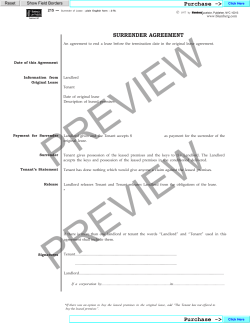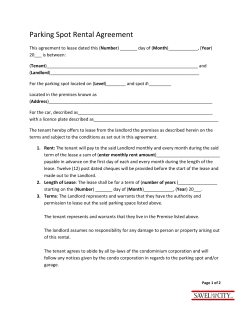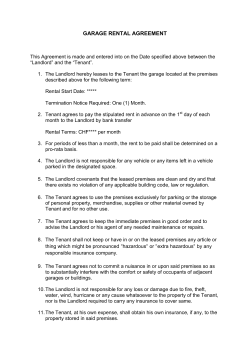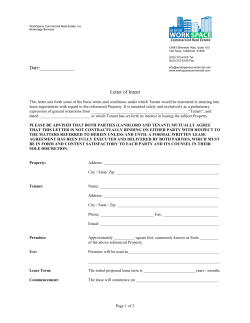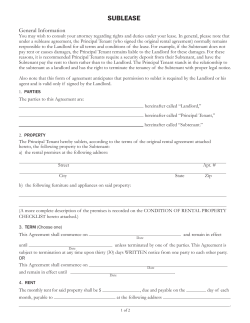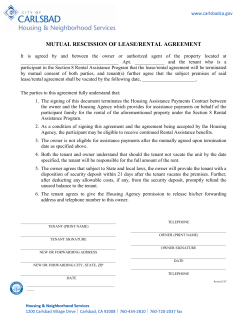
Lease Clauses (descriptions of common lease clauses with sample language)
Lease Clauses (descriptions of common lease clauses with sample language) 1. Identification of Landlord and Tenant The first clause in a lease agreement is typically the identification of the parties of the lease. The tenant(s) and landlord or owner should be stated. Example Clause: This Agreement is entered into between ________ (Tenants) and _______ (Landlord or Owner). 2. Identification of Premises Identification of premises clause states the address of the rental that is subject to the lease. Example Clause: Subject to the terms and conditions in this Agreement, Landlord rents to Tenant and Tenant(s) rents from Landlord, the premises located at __________ (Address of Rental). 3. Limits on Use and Occupancy A Limits on Use and Occupancy clause states the use of the premises and typically limits the use for residential purposes. This will avoid potential zoning violations and other concerns related to business operations. It also serves to limit long term guests. Example Clause: The premises are to be used only as a private residence for Tenants listed above. Occupancy by guests for more than __________ (time period, days) is prohibited without Landlord’s written consent and will be considered a breach of this Agreement. 4. Term of the Tenancy-Lease Length This clause sets the dates for when the lease begins and ends as well as establishes the tenant’s responsibility for rent for the entire period of time. Most leases are for one year. Liquidated damages, set amount of money charged to tenant if they break the lease early (damages), is not advisable and may be illegal. The landlord has a responsibility to try to reasonably rent the unit and typically can only charge for actually loss (such as rent, advertising, etc.). Example Clause: The term of the rental will begin on __________ and end on __________. If Tenant vacates before the term ends, Tenant will be liable for the balance of the rent for the remainder of the term. 5. Payment of Rent This clause states the amount of rent due as well as when, where and how it is to be paid. It provides a grace period if the 1st day of the month is a legal holiday or falls on the weekend. Example Clause: Tenant will pay to Landlord a monthly rent of $_____, payable in advance on the first day of each month, except when that day falls on a weekend or legal holiday, in which case the rent is due on the next business day. Rent payments should be sent to: ADDRESS and should be in the form of: PERSONAL CHECK, MONEY ORDER, CREDIT CARD, CASHIER’S CHECK and be made payable to: NAME FOR CHECKS 6. Late Payment Charges This clause states that Tenant’s will be responsible for late charges if the rental payment is past due. In Connecticut, Tenant’s have until the 10th day of the month before a Landlord can charge a late fee. A Landlord cannot provide a rent “discount” for paying before the 10th day of the month. Late charges should be reasonable. Example Clause: If the Tenant fails to pay their rent in full before the end of the 10th day after it’s due, Tenant will pay Landlord a late charge as follows: _________. 7. Returned Check Charges This clause outlines the charge to the tenant if the check is returned. Generally the charges should be reasonable and no more than any charges from your bank. Example Clause: If any check offered by Tenant to Landlord in payment of rent or any other amount due under this Agreement is returned for lack of sufficient funds, a “stop payment”, or any other reason, Tenant will pay Landlord a returned check charge of $__________. 8. Security Deposit This clause states the amount of security deposit the Landlord will require. The security deposit may not be more than two month’s rent or one month’s rent if the tenant is 62 or older. Example Clause: On signing this Agreement, Tenant will pay to Landlord the sum of $_____ as a security deposit. Tenant may not, without Landlord’s prior written consent, apply this security deposit to the last month’s rent or to any other sum due under this Agreement. Within 30 days after the Tenant has vacated the premises, returned keys, and provided Landlord with a forwarding address, Landlord will return the deposit, plus interest, in full or give Tenant an itemized written statement of the reasons for, and the dollar amount of, any of the security deposit retained by Landlord, along with a check for any deposit balance. 9. Utilities This clause outlines the expectations of who pays for utilities and will help prevent any misunderstandings. It may be advisable to have the Tenants put the utilities in their name, if they are responsible for payment, to avoid collection issues. Example Clause: Tenant will pay all utility charges, expect for the following, which will be paid by the Landlord: __________. 10. Assignment/Subletting This clause will allow the Landlord to appropriately screen potential tenants under a sublease or assignment change. Example Clause: Tenant will not sublet any part of the premises or assign the Agreement without the prior written consent of Landlord. 11. Tenant’s Maintenance Responsibilities This clause outlines the expectations of upkeep and damages responsibility. (A sample Move-In/Out Checklist referenced can be found on the Off-Campus Student Services website). Example Clause: Tenant will: (1) keep the premises clean, sanitary, and in good condition and, upon termination of the tenancy, return premises to Landlord in a condition identical to that which existed when Tenant took occupancy, expect for ordinary wear and tear; (2) Immediately notify Landlord of any defects or dangerous conditions in and about the premises of which Tenant becomes aware; and (3) reimburse Landlord, on demand by Landlord for the cost of any repairs to the premises damaged by Tenant or Tenant’s guests through misuse or neglect. Tenant has examined premises, including appliances, fixtures, carpets, drapes, and paint, and has found them to be in good, safe, clean condition and repair, expect as noted in the Move-In Checklist. 12. Tenant Alterations This clause outlines expectations of tenant repairs and alterations. It also makes sure you are able to access the property, especially in an emergency situation. Note that regardless of what is stated in the lease, Tenants may have the ability to make alterations legally and without consent (i.e. Fair Housing-disabled persons, FCC-wireless or satellite dishes, Connecticut Statues-Energy conservation measures, etc.). Example Clause: a. Except as provided by law, or as authorized by the prior written consent of Landlord, Tenant will not make any repairs or alterations to the premises, including nailing holes in the walls or painting the rental unit. b. Tenant will not, without Landlord’s prior written consent, alter, rekey, or install any locks to the premises or install or alter any burglar alarm system. 13. Violation of Laws/Disturbances This clause outlines expectations of impact on neighbors and the Tenant’s right to not have their ability to use the rental by the action or inaction of the Landlord. This clause gives you leverage to address behavior of tenants that may be violating the law, town ordinance and/or disturbing to other tenants or neighbors. More specific expectations can be added to a “Tenant Rules and Regulations Section”. Example Clause: Tenant agrees not to allow on the leased premises any unlawful activity or any excessive noise or other activity which disturbs the peace and quiet of other tenants and other persons in the building, common areas or neighbors. Tenant understands that he/she is responsible for the conducts of invitees and guests at the leased premises, on the common grounds of the apartment complex, and in the building. Illegal, lewd, abusive, profane or otherwise disturbing conduct by the guests of the tenant shall be attributable to tenant and shall constitute a violation of the terms of this lease. Tenant further agrees that he/she is and shall be liable for any injury or damage done to the leased premises, the building and grounds in which the same are located, or the common grounds of the apartment complex, by the guests or invitees of tenant. Tenant will pay for any fines or penalties that the landlord accrues due to actions and/or inactions of the tenant and/or guests of the tenant. 14. Pets This clause covers expectations regarding pets that are allowed to reside on the premises. Landlords are allowed to restrict pets with the exception of trained dogs used by the blind, deaf, or physically or mentally disabled. If a Landlord would like to allow pets, they should clearly outline specific expectations, if any are desired, like limits on the number of pets, weight, and/or types. Pet deposit could be required in order to accept pets. Example Clause: No animal, bird, or other pet will be kept on the premises, even temporarily, expect properly trained service animals needed by blind, deaf, or disabled persons. 15. Landlord’s Right to Access This clause outlines the expectations regarding access to the premises by the Landlord. The Landlord has the rent to enter the property under certain conditions, including emergencies, make repairs and/ or inspections, and to show the unit to perspective tenants or buyers. Connecticut State Law dictates the parameters for legal entry by the Landlord, regardless of what is agreed to in the lease. Example Clause: Landlord’s or Landlord’s agents may enter the premises in the event of an emergency, to make repairs or improvements, or to show the premises to prospective buyers or tenants. Landlord may also enter the premises to conduct inspections for safety or maintenance problems. Except in the cases of emergency, Tenant’s abandonment of the premises, court order, or where it is impractical to do so, Landlord shall give Tenant 24 hours notice before entering. 16. Extended Absences by Tenant This clause requires the Tenant to notify you if they are going to be absent for the premises for an extended period of time (10-14 days is common). This gives you permission to check that the heat is at a minimum level in the winter, for example, to avoid frozen pipes. Example Clause: Tenant will notify Landlord in advance if Tenant will be away from the premises for __________ or more consecutive days. During such absence, the Landlord may enter the premises at times reasonably necessary to maintain the property and inspect for needed repairs. 17. Possession of Premises This clause outlines expectations about the Tenant’s responsibility to take fully execute the lease and the Landlord’s responsibility if the premises is not available to tenant for reasons beyond the control of the Landlord (i.e. fire or other damage). The Landlord may not just collect unpaid rent, but must make reasonable attempts to rent an unoccupied unit due to Tenant’s failure to execute the lease. Example Clause: a. Tenant’s failure to take possession. If, after signing this Agreement, Tenant fails to take possession of the premises, Tenant will still be responsible for paying rent and complying with all other terms of this Agreement. b. Landlord’s failure to deliver possession. If Landlord is unable to deliver possession of the premises to Tenant for any reason not within Landlord’s control, including, but not limited to, partial or complete destruction of the premises, Tenant will have the right to terminate this Agreement upon proper notice as required by law. In such event, Landlord’s liability to Tenant will be limited to return of all sums previously paid by Tenant to Landlord. 18. Tenant Rules & Regulations This clause states that the Tenant acknowledges a set of rules and regulations that are not stated in the lease, but are expected to be followed. Establishing a set of rules and regulations separate from the lease allows some flexibility in the rules without causes a violation of the lease agreement. For example, changing pool hours for a good reason that does not significantly affect the tenants use and enjoyment of their tenancy would probably be acceptable. However, closing the laundry facilities to save money would probably not be seen as reasonable. This section could be used to limit the number of total guest allowed in the unit or on the property as well as restrict the use of kegs of any type and other common source alcohol containers. Example Clause: Tenant acknowledges receipt of, and has read a copy of, tenant rules and regulations, which are attached to and incorporated into the Agreement by this reference. Tenant Initials __________ 19. Disclosures (i.e. Lead Paint) This clause states that you have provide the disclosures required by law. For example, federal law requires landlords to disclose any known lead-based paint hazards in rental premises constructed prior to 1978. Some problems may need to be fixed and not just disclosed. For example, if the landlord is aware of problems with an appliance overheating and there is a fire, the landlord may find they are liable if they do not repair and just disclose the problem. Example Clause: Tenant acknowledges that Landlord has made the following disclosures regarding the premises: _____Disclosure of Information on Lead-Based Paint and/or Lead Based Paint Hazards _____Provide a copy of the "Protect Your Family from Lead in Your Home" pamphlet 20. Grounds for Termination This clause states that any violation of the lease by the tenant, or tenant’s guests, is grounds for terminating the tenancy based on state and local laws. Being clear that the tenant is responsible for the actions of their guests is important. You my become aware that there has been damage caused, drugs being sold or pets being brought by guests. You should be clear that you will address these scenarios. This clause also states that if the tenant provided false information on the rental application, it may also be grounds for termination of the tenancy and eviction proceedings if needed. Example Clause: The failure of Tenant or Tenant’s guest to comply with any term of this Agreement, or the misrepresentation of any material fact on the Tenant’s rental application, is grounds for termination of the tenancy, with appropriate notice to Tenant and procedures as required by law. 21. Entire Agreement This clause states that the lease agreement and any attachments (i.e. rules and regulations) constitute the entire agreement between you and your tenant. Oral promises, by both you and the tenant are non-binding. Any changes must be in writing. Example Clause: This document constitutes the entire Agreement between the parties, and no promises or representations, other than those contained here and those implied by law, have been made by the Landlord or Tenant. Any modifications to this Agreement must be in writing signed by Landlord and Tenant. 22. Landlord Contact Information This clause states the contact information for the landlord. This should include a contact for emergency and non-emergency needs. These may be different numbers if you authorize an agent to act on your behalf. Example Clause: The following is the Landlord’s (or Agent’s) contact information: 23. Signatures/Cosigners This clause is to formally accept the terms of the agreement. It should include a place for the signatures of all tenants. Tenant’s phone numbers could also be included. Co-signers are often requested for individuals who do not meet income requirements. The Landlord, tenants and cosigners should get a copy of the signed lease. It is best to have copies of the original lease, based on the number of tenants, co-signers and landlords, and have everyone sign a copy. *Disclaimer: This information is maintained to enhance University of Connecticut students’ access to information about resources for living offcampus and/or commuting to the University of Connecticut-Storrs Campus. While every effort is made to ensure the accuracy of the information, Off-Campus Student Services and the University of Connecticut make no guarantees and are neither responsible nor liable for misprints or typographical errors. The information was collected from various sources and leases. Legal Information Is Not Legal Advice This information about the law is designed to help University of Connecticut students understand their legal rights and responsibilities. Legal information is not the same as legal advice -- the application of law to an individual's specific circumstances. This publication provides general information about Connecticut landlord/tenant law. This information pertains only to Connecticut Law; this area of law differs significantly from state to state. While all publications are reviewed to be reasonably accurate, there is a chance that the governing law has changed since the information's publishing. For this reason, you should not rely on the information available here. If you find any errors or complaints pertaining to any of the pages on this web site, please contact the Off-Campus Student Services as soon as possible. If you plan to take any action based on information you found in this website, you must first consult an attorney. Your questions and facts are specific to your case. This website cannot substitute for legal advice from an attorney licensed to practice in your jurisdiction. Under no circumstances shall the University of Connecticut or its employees be liable for any direct, indirect, incidental, special, punitive, or consequential damages which may result in any way from your use of the information included on this website.
© Copyright 2025
